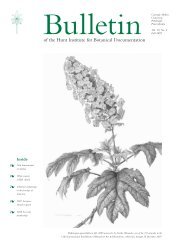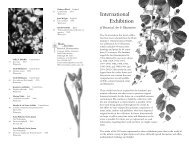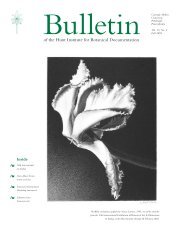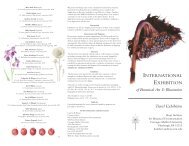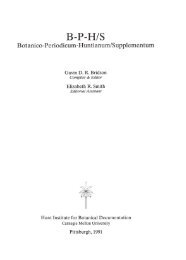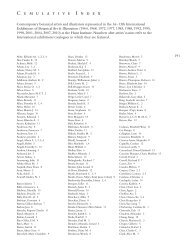Volume 17, No. 2. 2005. - Hunt Institute for Botanical Documentation
Volume 17, No. 2. 2005. - Hunt Institute for Botanical Documentation
Volume 17, No. 2. 2005. - Hunt Institute for Botanical Documentation
You also want an ePaper? Increase the reach of your titles
YUMPU automatically turns print PDFs into web optimized ePapers that Google loves.
Bulletinof the <strong>Hunt</strong> <strong>Institute</strong> <strong>for</strong> <strong>Botanical</strong> <strong>Documentation</strong>Carnegie MellonUniversity,Pittsburgh,PennsylvaniaVol. <strong>17</strong>, <strong>No</strong>. 2Fall 20054444InsideInspiration and Translation:<strong>Botanical</strong> and HorticulturalLithographs of Joseph Presteleand Sons on displayLawrence award recipientJapanese artworks and booksAssociates program expanded
Current and upcoming exhibitsInspiration and Translation: <strong>Botanical</strong> and HorticulturalLithographs of Joseph Prestele and Sons opensIn collaboration with Special Collections of the NationalAgricultural Library (NAL), Beltsville, Maryland, the <strong>Hunt</strong><strong>Institute</strong> is exhibiting artworks by the 19th-century botanicalpainter and master lithographer Joseph Prestele and histhree sons. Joseph and his family were members of the TrueInspirationists, a German communal society that emphasizedindividual piety and humility within abrotherhood of believers. In search ofreligious and economic freedom, membersof the society began to emigrate to theUnited States in 1843, settling in Ebenezer,New York. By 1845 the community eldersgave Joseph permission to pursue the sametype of work he had done in Germany,illustrating important works by Europeanbotanists. Skilled in botany, painting,and the German lithographic techniqueof engraving on stone, Joseph began toproduce work of aesthetic and scientificvalue <strong>for</strong> leading 19th-century Americanbotanists such as Asa Gray (1810–1888)and John Torrey (<strong>17</strong>96–1873) and <strong>for</strong>the Smithsonian Institution. He oftentranslated the work ofother artists such as IsaacSprague (1811–1895) tolithographic stone <strong>for</strong>printing, and he was anengraver <strong>for</strong> many of thePacific Railroad Reports.By the early 1850s he andhis sons were among thefirst to produce fruit andflower plates <strong>for</strong> nurseriesand horticulturists. Withthe community’s movei n 1858 to A m a n a,Iowa ( becoming theAmana Society), JosephPrestele was cut of ffrom the northeasternbotanists, and he beganto concentrate on the production of nurseryman plates. Histhree sons, Joseph Jr. (1824–1880s), Gottlieb (1827–1892), andWilliam Henry (1838–1895), followed their father’s artisticfootsteps in their own capacity. Gottlieb stayed in the religiouscommunity and worked alongside his father — continuingwith their nursery plate business after Joseph’s death. JosephJr. helped with the hand coloring of plates after he left thecommunity <strong>for</strong> New York City. William Henry followed hiselder brother to New York by 1858, served in the Civil War,and worked <strong>for</strong> F. K. Phoenix in Bloomington, Illinois, from1867 to the early 1870s, where he supervised the productionof fruit and flower plates. William Henry eventually startedhis own nursery plate business, and by 1887 he was the firstartist employed by the newly <strong>for</strong>med Pomological Division ofthe U.S. Department of Agriculture. There he, and eventuallyother artists, illustrated many new varieties. Today these worksby Joseph Prestele and his sons are an important record of therich horticultural history of 19th-century America.Marcelee Konish, who is Joseph Prestele’s great-greatgreat-granddaughter,is generously sharing her collection ofPrestele watercolors, lithographic prints, account books andother ephemera, which include the botanical work JosephPrestele created <strong>for</strong> prominent botanists in Germany, workhe and his sons did <strong>for</strong> American botanists and horticulturists,and fruit and flowerplates created <strong>for</strong>nurserymen. Josephand Gottlieb’s twoaccount books <strong>for</strong>the years 1845–1854and 1858–1877 arean important recordof their transactionswith botanists andnurserymen of theperiod. All payments<strong>for</strong> the engravingand sale of plates aswell as the cost oflithographic stones,paper a nd i n k s ,went through thiscommunal society’sstore where recordso f t r a n s a c t i o n swere kept <strong>for</strong> eachm e m b e r — w i t hcredits <strong>for</strong> incomebrought into the community and debits <strong>for</strong> each itempurchased. We have been able to match specific artworks fromthe collections of Marcelee Konish and the <strong>Hunt</strong> <strong>Institute</strong> toitems noted in the 1845–1854 account book, such as workcreated <strong>for</strong> Asa Gray’s “Chloris Boreali-Americae” (1846)and Genera Florae Americae (1848), <strong>for</strong> George Emerson’sReport on the Trees and Shrubs Growing Naturally in the ForestsTop: Page spread of “Einschreibbuch” 1845–1854 showing theaccounts <strong>for</strong> the botanist John Torrey <strong>for</strong> the Pacific Railroad Reportsof Lt. A. W. Whipple and Lt. John G. Parke. Most entries are <strong>for</strong>the engravings Prestele made from other artists’ drawings. On theright page of the account book are listed 22 engravings made <strong>for</strong> Dr.Engelmann’s work on Cactaceae (including the engraving shown tothe left) <strong>for</strong> Whipple’s expedition. Bottom: 1., <strong>2.</strong> Opuntia vulgaris.3–5. Op. rafinesquii, proof plate of engraving by Joseph Prestelefrom drawing by Paulus Roetter and H. B. Möllhausen printed byAckerman & Co., New York, <strong>for</strong> George Engelmann and J. M.Bigelow’s “Description of the Cactaceae, route near the 35th parallel,explored by Lt. A. W. Whipple ...” (1856, vol. IV, pt. 5, no. 3, pl.10) in the U.S. War Department’s Reports of Explorations andSurveys, to Ascertain the Most Practicable and EconomicalRoute <strong>for</strong> a Railroad Route from the Mississippi River to thePacific Ocean ... 1853–[1856] (Washington, 1855–1860, 12 vols.in 13). Both from the collection of Marcelee Konish.2Bull. <strong>Hunt</strong> Inst. Bot. Doc. <strong>17</strong>(2), Fall 2005
Current and upcoming exhibits(continued from page 3)Spring 2006 exhibitionWe will present the exhibition Yuuga: Contemporary <strong>Botanical</strong> Watercolors from Japan,including about 46 works — the majority of them donated — by 32 artists, from23 March to 30 June 2006. A tentative list of artists represented in the exhibitionincludes Junzo Fujishima, Rei Fukuzawa, Tadako Hayashi, Mieko Ishikawa,Michiko Ishiyama, Yoko Kakuta, Yumi Kamataki, Yoshiko Kamei, Seiko Kijima,Sanae Kikuchi, Yuriko Kikuchi, Hidenari Kobayashi, Mariko Kojima, MiekoKonishi, Makiko Makihara, Naomi Morino, Sadao Naito, Yoko <strong>No</strong>mura, YoaiOhta, Takeko Sagara, Masao Saito, Masako Sasaki, Toshi Shibusawa, AkikoShimizu, Fumiko Sugizaki, Kiyohiko Sugizaki, Kazuko Tajikawa, MiyakoTakahashi, Kiyoko Tanaka, Yoko Uchijo, Keita Yonezu and Keiko Yoshida.In conjunction with the exhibition, artworks by 11 of Ms. Yoshiko Kamei’sstudents will compose the first exhibition held in the new rotunda at PhippsConservatory and <strong>Botanical</strong> Gardens. The students’ paintings are based on theplants represented in their traditional family emblems, which are passed fromgeneration to generation. In the emblem the plant image is reduced to its essenceand used on kimonos and decorative items. The student exhibition at Phipps willbe on display from 1 March to 30 June 2006.Flowers have always played an important role in Japanese culture, and in recentyears The Japan Association of <strong>Botanical</strong> Illustration has encouraged artists,produced exhibitions with catalogues, and issued a journal. JABI has stimulatedThe 2005 Lawrence Memorial AwardThe Lawrence Memorial Award commemoratesthe life and achievements of Dr. George H. M.Lawrence (1910–1978), founding director of <strong>Hunt</strong><strong>Institute</strong> (1961–1970). The annual (semiannualfrom 1988 to 2000) award in the amount of$2,000 is given to an outstanding doctoralcandidate <strong>for</strong> travel in support of dissertationresearch in systematic botany or horticulture,or the history of the plant sciences, includingliterature and exploration. The recipient of theaward is selected from candidates nominated bytheir major professors. <strong>No</strong>minees may be fromany country, and the award is made strictly onthe basis of merit — the recipient’s general scholarly promise and the significanceof the research proposed. The award committee includes representatives from the<strong>Hunt</strong> <strong>Institute</strong>, the <strong>Hunt</strong> Foundation, the Lawrence family, and the botanicalcommunity. The award is presented at the annual banquet of the <strong>Botanical</strong> Societyof America.Ricarda Riina, a student of Professor Paul E. Berry at the University ofWisconsin — Madison, is the recipient of the 2005 Lawrence Memorial Award.For her dissertation research, Ms. Riina is constructing a phylogeny of Crotonsect. Cyclostigma (Euphorbiaceae) and plans to use the resulting data to undertakea taxonomic revision of the section, which consists of approximately 80 speciesdistributed from Mexico to northern Argentina with a few in Africa and Madagascar.She has already conducted fieldwork in Ecuador, Peru, and Bolivia, where mostspecies of sect. Cyclostigma occur. With the proceeds of the award, she will completefurther sampling of taxa through fieldwork in southeastern Brazil, the second majorarea of diversity of the dragon’s blood trees.additional exhibitions and books,even bringing exhibitions to Japanfrom abroad, such as those from thecollections of Dr. Shirley Sherwoodand the Royal Horticultural Society’sLindley Library. As a result, Japan easilyranks in the top half dozen countries toactively promote the genre of botanicalart. Since mounting the exhibitionTalking in Flowers: Japanese <strong>Botanical</strong>Art in 1982, the <strong>Hunt</strong> <strong>Institute</strong> hasbeen interested in the subject. Weare pleased to take this opportunityto display our growing collection ofJapanese botanical art.We consider an exhibition catalogue tobe an important record of an exhibition.Without it, authoritative essays arenot written; artworks eventually arereturned to their respective boxes orowners, and all remains only a pleasantmemory, which quickly fades. Weare unaware of any other exhibitioncatalogue produced in the UnitedStates on this subject, and indeed wewere planning to do an exhibitioncatalogue. In fact, an important figurein The Japan Association of <strong>Botanical</strong>Illustration, Kazunori Kurokawa,honorary curator of <strong>Hunt</strong> <strong>Institute</strong>and honorary director of the AmericanSociety of <strong>Botanical</strong> Artists, hadoffered an essay “Contemporar ybotanical art in Japan and its historicalbackground” <strong>for</strong> such a catalogue.Due to financial exiguity, one will bepossible only with donations. Printinga 72-page illustrated color cataloguewith essay will cost approximately$15,000, of which one-half has beenraised thus far.For a donation of $100, individualsand organizations can have their nameslisted in the front of the catalogue.Gifts can also be made in memoryof a loved one. Donors will receive acomplimentary copy of the catalogueupon publication and an invitation tothe preview reception. If you wouldlike to join us in producing our springcatalogue, send a donation in anyamount by 3 January 2006.— James J. White, Curator of ArtBull. <strong>Hunt</strong> Inst. Bot. Doc. <strong>17</strong>(2), Fall 2005 5
Delectus <strong>Hunt</strong>iana 39Japanese items at the<strong>Hunt</strong> <strong>Institute</strong>19th-century Japanese artworksMrs. <strong>Hunt</strong>’s collection of botanical artemphasized European works, thoughwe have read in her 1961 catalogue ofher interest in the Orient. Even WilfridBlunt’s coverage of Japanese andChinese botanical painting is minimalin his classic work on botanical art. Far-Eastern art is a vast genre, complicatedover the dynasties with calligraphy,associative meanings, theme-relatedpoetry and prose, and variations inartists’ names. Of the 19th-centuryJapanese artworks at the <strong>Hunt</strong> <strong>Institute</strong>,only two multiple-volume albums, twoscrolls and a few separate wood-blockprints can be enumerated.Our 3-volume album of 211 watercolorsby Seifuku Okada (an attribution we areunable to confirm) is titled in Chinesecharacters “Soomoku Zufu, volumes1, 2 and 3.” Bound with double-leaves,oriental style, 26 × 19 cm, a varietyof genera is depicted — at least 30 inthe Compositae. Many of the imagesspread across two pages, and all pagesare defaced by wormholes. In a randomsampling, we matched six watercolorsof Pinellia (see reproduction of P. ternataBreitenb. center of p. 7) with woodblockprints in Iwasaki Tsunemasa’s,a.k.a. Iwasaki Kan’en (<strong>17</strong>86–1842),Honzō Zufu, vol. 19; and a Dicentraspectabilis Mig. and composite in vol.44. (See Bartlett and Shohara 1961,p. 135.) At present we are unable toascertain the connection betweenOkada and Iwasaki.Kōkei or Kōdō Yoshikawa’s six albumsin ink and watercolor, approximately40 × 32 centimeters, were transferredat the <strong>Hunt</strong> <strong>Institute</strong> into two custommadeboxes. We interpret the labels as“Kōkei’s drawings from life — plants,animals and fish of the four seasons,1822,” “Kōkei’s drawings from life —plants of the four seasons, 1825,”“Kōkei’s drawings from life — plantsof spring, summer and autumn, 1826,”“Kōkei’s drawings from life — plants,insects and people,” “Collection ofdrawings from life. <strong>No</strong>. 1, Spring1855,” and “Collection of drawings6Bull. <strong>Hunt</strong> Inst. Bot. Doc. <strong>17</strong>(2), Fall 2005
from life. <strong>No</strong>. 2, Spring 1855.” Twentytwoof these images were prominentlyfeatured in our catalogue Talking inFlowers: Japanese <strong>Botanical</strong> Art (1982).Ito Mihashi is reported to be the artistof our two scrolls, which measure22 × 764 centimeters and 24 × 12<strong>17</strong>centimeters, are mounted on bonetippedrollers, and have silk brocadeend strips. Chiefly in ink, with somewatercolor, the scrolls contain manyinscriptions, including the name andsource of the plant, the gardens inwhich the plants grew (sometimes theartist’s own), color notations, and dates(which correspond to 1867 and 1868).In some inscriptions, Mihashi used astudio name, Seikando (“drawn fromlife by Seikando”). A mouse, butterfliesand turtles are included among theplants on the scrolls.The <strong>Institute</strong> owns a few 19th-centuryJapanese wood-block prints acquiredin 1981 from commercial galleries inPhiladelphia and Boston. We have oneby Katushika Hokusai (<strong>17</strong>60–1849),two by Isai (1821–1880), and two byGessho (<strong>17</strong>72–1832).In the 1960s the scrolls and albumswere acqu i red f rom P rofe s sorRudolph (1909–2003), “father ofChinese studies” at the University ofCali<strong>for</strong>nia, Los Angeles, where he wasinstrumental in building what is nowthe Richard C. Rudolph East AsianLibrary. Interestingly, in <strong>Hunt</strong>ia (1965)Rudolph compared the illustrationsin Johann Wilhelm Weinmann’s18th-century Phytanthoza Iconographiato those that Iwasaki had adaptedwith acknowledgement <strong>for</strong> his HonzōZufu.Readers are encouraged to contributeadditional in<strong>for</strong>mation about ourholdings or to inquire further aboutthem.— James J. White, Curator of ArtInk and watercolor from scrolls byIto Mihashi, HI accession 6480 (topand bottom); watercolors from album bySeifuku Okada (middle) of Iris,HI accession 669<strong>2.</strong>246–247 (left)and Pinellia ternata Breitenb.,HI accession 669<strong>2.</strong>16–<strong>17</strong> (right).(continued on page 8)Bull. <strong>Hunt</strong> Inst. Bot. Doc. <strong>17</strong>(2), Fall 2005 7
Delectus <strong>Hunt</strong>iana 39(continued from page 7)18th- and 19th-centuryJapanese booksAlthough much of our rare bookcollection reflects a focus on occidentalbotanical history, we are <strong>for</strong>tunate tohave some books from Asian countrieson plants and botanical history. Amongthese are a number of Japanese booksthat the Librar y acquired in the1960s, many published in the 18th or19th centuries. In terms of Japanesehistory, they are from the Edo period(1603–1867) and the Meiji period(1868–1912). In Japanese Botany duringthe Period of Wood-Block Printing, HarleyHarris Bartlett and Hide Shoharanote that pre-Meiji period bookstypically contain text reproducedfrom woodblocks engraved witha cursive mixture of Chinese andJapanese characters. Many of the olderJapanese books in our collection,even in the Meiji period, f it thisdescription, and most are illustrated.Our sources <strong>for</strong> older Japanese booksacquired in the 1960s includedNelson Coon, Dawson’s Book Shop,Georges Heilbrun, Libraire Orientale,B. Y. (Benjamin Yoe) Morrison, andRichard C. Rudolph. These booksinclude works on wild and cultivatedplants, economic botany, naturalhistory, social culture, and gardens.It should be noted that, because Idon’t read Japanese, my in<strong>for</strong>mationis based on our cataloguing records,in<strong>for</strong>mation from secondary sources,and observation of the books.One of the older works from Japan inour Library is Ehon Yazansō (Picturebooks of mountain and field plants)(Osaka, Shibukawa Seiemon, <strong>17</strong>55)by Hōbashi Yasukuni. The book (Fig.1) contains images of individual plantsand habitat groups. Illustrated byTachibana Yasukuni and engraved byFujimura Zen’emon and Fujie Shirōbei,this work was described by Bartlett andShohara as “one of the most interestingand charming works of old Japanesebotany” (1961, p. 126).Kawahara Keiga (b. <strong>17</strong>86?), who mademany drawings <strong>for</strong> Philipp Franz vonSiebold (<strong>17</strong>96–1866) during the latter’stime in Japan, compiled and illustratedSōmoku Kajitsu Shashin Zufu (Osaka,8Bull. <strong>Hunt</strong> Inst. Bot. Doc. <strong>17</strong>(2), Fall 2005From top: Figures 1, 2, 3.Maekawa Zenbei, 1842), a four-volume collection of pictures of plants and fruitsprinted in color, some of which remains quite vivid in our copy. Bartlett andShohara attributed the depiction of details of flower structure and naturalisticdrawing style to von Siebold’s influence. English or Latin names of plants areincluded on each wood-block print.Another European connection exists in Honzō Zufu (Edo, Suharaya, Mohei& Yamashiroya, Sahei, 1830) by Iwasaki Tsunemasa, a.k.a. Iwasaki Kan’en(<strong>17</strong>86–1842). In his <strong>for</strong>eword, as quoted by Richard C. Rudolph, Iwasaki wrotethat he drew pictures of all of the plants that he was able to examine personally,but that some <strong>for</strong>eign plants were also added from a source that Rudolph (1965)has identified as the work of Johann Wilhelm Weinmann (1683–<strong>17</strong>41), as well assome from works by von Siebold and Rembert Dodoens (15<strong>17</strong>–1585), always withacknowledgement. Iwasaki painted some 2,000 plant portraits, which he thenbegan to publish. We hold four volumes from the original printed edition of HonzōZufu (Illustrated manual of plants), and that may be the extent of that edition. Asecond, manuscript edition, completed over 25 years and comprising 92 volumes,
is extremely rare. In the early 20th century, a new wood-block printed editionwith colored illustrations was published. We are <strong>for</strong>tunate to have a complete setof this later printed edition (Tokyo, Honzō Zufu Kankōkai, 1916–1922), whichruns to 95 volumes and includes a 2-volume index by Shirai Mitsutarō.An elegant work (Fig. 2) depicting leaves from trees, shrubs, ferns and herbaceousplants is the seven-volume Sōmoku Kin’yōshū (Collection of tree leaves) (Kyoto,Katsuura Jiemon, [et al.], 1829) by Mizuno Chūkyō. The striking, high-contrastimages particularly emphasize variegated foliage. Bartlett and Shohara list theartists as Ōoka Umpō and his disciple Sekine Untei. Shirai referred to this as oneof the best Japanese books of plant illustrations. Rudolph cited this work as anexample of illustrated works in the field of horticultural botany that demonstratedthe virtuosity of the artists, engravers and printers of the time.Kōno Bairei (1844–1895) produced beautiful collections of pictures of Japanesewildflowers under the title Chigusa <strong>No</strong> Hana (Flowers of a thousand kinds) (Kyōtoshi,Bunkyūdō, 1889). We also have a later edition in four volumes publishedposthumously (Kyoto, Yamada Unsōdō, 1905). In both editions there are 50 picturesper volume with brief plant descriptions. Another work on flowers by Kōno Bairei,Kusabana Hyakushu, was edited by his heir Kōno Seiko (1881–1945) and publishedposthumously (Kyoto, Yamada Naosaburō, Yamada Unsōdō, 1901–1904). Someof the volumes from these several editions contain lists of illustrations and Arabicnumbering. Bartlett and Shohara called Kōno Bairei “one of the last of the artistswho illustrated plants <strong>for</strong> wood-block printing and whose work is considered bycritics as important” (1961, p. 237).We have a number of Japanese books about garden flowers as well as wild flowers.One such work is Kadan Asagaotsū (Edo, Yamashiro Sahei, 1815) by Kōtendō Shujin(fl. 1814). These are two small volumes of pictures of morning glories drawn byMori Shunkei, printed in color and accompanied by short poems.Our collection also includes several older Japanese works about gardens. Twoexamples typical of our holdings in this area are collections of uncolored viewsof gardens and garden landscapes. Tsukiyama Teizō Den (Osaka, [s.n.], <strong>17</strong>35) byKitamura Enkin (fl. <strong>17</strong>35) is about building gardens and is illustrated by ShigeyoshiFujii. We have two of the three volumes published. Tsukiyama Teizōden (Osaka,[s.n.], 1859) by Akisato Ritō contains garden views incorporating walkways, water,walls and buildings. We have only one volume, and according to our cataloguerecord, our copy may be a later impression from the original blocks.We have several works about specific places that were written by unknown authors.Hokeutsu Shashin (Tokyo, [s.n.], <strong>17</strong>90) treats the natural history of the province ofEchigo with beautiful paintings of plants, mushrooms, fish, birds and rocks renderedon glistening paper. Our catalogue records indicate that ours is a copy of an originalwork held in the National Diet Library in Tokyo.Izu Shichitō shi ([S.l., s.n.],<strong>17</strong>54) is a six-volume account of a voyage made to theIzu Islands to study geography, customs, and natural history (Fig. 3). In feudaltimes, these islands served as a place of exile <strong>for</strong> political prisoners. The accountcontains references to Chinese and Japanese herbals, and includes both single- anddouble-page illustrations colored by hand. We also have an album of nature printingmade by Utsunomiya Kōnoshin, filled with images printed from plants gatheredon a trip to Izu during May and June of 1867. The pages are annotated with plantnames in Japanese and occasionally also in Latin or French. The book seems tocontain two volumes bound as one, as the pages are numbered in pencil in Arabicnumerals in two runs, with an extra manuscript title page in between.Gokinai Sanbutsu Zue by Ōhara Tōno was published in five volumes (Osaka, ShioyaHeisuke, Shioya Chobei, Kawachiya Kihei and Kawachiya Tasuke, 1813). Ōharadiscusses natural products of Settsu, Izumi, Kawachi, Yamato and Yamashiro,emphasizing plants and animals used as food, with color-printed illustrations donein a simple, almost cartoon-like style.Nagasaki Bunkenroku (Osaka and Kyoto, [s.n.], 1800) is one of the chief in<strong>for</strong>mationsources on the Dutch Island of Deshima in Nagasaki harbor, to which early Dutchtraders were restricted during the period 1641–1858. Bound as five volumes in two,the work contains in<strong>for</strong>mation on social life and customs as well as medicinal usesof plants, with illustrations of plants,animals, people, tools, buildings,boats, processions, and such activitiesas fishing with nets and digging clams.The covers are impressed with wavelikepatterns onto which small boats havebeen painted with a few strokes.Finally, Rudolph mentioned a genre ofillustrated geographical works called“meisho zue,” or “pictures of famousplaces,” saying that these extensivelyillustrated works could cover the entirecountry or the grounds of a single site.At least two examples can be foundin our Library. Miyako Rinsen MeishōZue (Kyoto, Yoshinoya Tamehachi;Edo, Suharaya Zengorō, <strong>17</strong>99) byAkisato Ritō (fl. <strong>17</strong>80–1814) featurespictures of gardens and festivals bythree artists: Sakuma Sōen, NishimuraChūwa [Baikei] (<strong>17</strong>58–1835), and OkuBunmei. Another such work, KompiraSankei Meishozue (Famous scenes ofKotohira Shrine) (Osaka, MaekawaZembei, ca.1847) by Gyō Shōsei, is asix-volume travel account full of imagesof processions, warriors, buildings,gardens, rainstorms, fishermen, boats,and more, and the text includesdescriptions of festivals.We are pleased to have these beautifulJapanese books in our Library and tolearn what we can of their historical andcultural context and their significance.— Charlotte Tancin, LibrarianReferencesBartlett, H. H. and H. Shohara. 1961.Japanese Botany during the Period ofWood-Block Printing. Los Angeles:Dawson’s Book Shop. (Reprint, orig. ed.1961, Asa Gray Bull., n.s., 3: 289–561.)Rudolph, R. C. 1965. Illustrations fromWeinmann’s Phytanthoza Iconographia inIwasaki’s Honzo Zufu. <strong>Hunt</strong>ia 2: 1–28.Rudolph, R. C. 1966. Illustrated botanicalworks in China and Japan. In: T. R.Buckman, ed. 1966. Bibliography andNatural History: Essays Presented at aConference Convened in June 1964.Lawrence, Kans.: University of KansasLibraries. Pp. 103–120. [<strong>Hunt</strong> <strong>Institute</strong>’sArchives has a typescript of Rudolph’snotes <strong>for</strong> the original lecture on whichthis paper was based.]Shirai Mitsutarō. 1943. Nihon HakubutsugakuNenpyō, Kaitei zōho (Chronologicaltable of Japanese studies of natural history,revised and enlarged). Tokyo: OokayamaShoten. [<strong>Hunt</strong> <strong>Institute</strong>’s Archives has apreliminary English translation of theentries <strong>for</strong> the years <strong>17</strong>30–1840 and a listof the books mentioned in the text.]Bull. <strong>Hunt</strong> Inst. Bot. Doc. <strong>17</strong>(2), Fall 2005 9
News from the ArchivesRonald L. Stuckey, professor emeritus of botany at The OhioState University at Columbus, paid a fruitful visit to the <strong>Hunt</strong><strong>Institute</strong> in June. <strong>No</strong>t only did Stuckey bring correspondenceand other additions to his ever-growing archival collection,but he also introduced us to Mac Al<strong>for</strong>d, assistant professorand curator of the Herbarium at the University of SouthernMississippi. Al<strong>for</strong>d also brought donations <strong>for</strong> Archives —mostly photographs of the emerging generation of botanistslike the one below of a group of young women, some ofwhom were students from Kevin Nixon’s “Tropical PlantSystematics” class at Cornell: (l–r) Marcela Martínez Millán,Mariana Yazbeck, Katherine E. Bushley, Amanda Ingram,Shannon C. K. Straub, and Erica L. Wilhelm, photographedby Al<strong>for</strong>d near Mercedes, Corrientes Province, Argentina inJanuary 2004.Also at the suggestion of Ronald Stuckey, Hal deSelm, <strong>for</strong>merprofessor of botany and ecology at the University of TennesseeBotany Department, sent a wonderful collection of individualand group portraits, mostly slides. His donation of finefield photos helps us outsiders to imagine what those plantcollectingtrips are like, and it included portraits of elusivesubjects such as Elsie Quarterman (b. 1910) and <strong>No</strong>rman H.Russell (below). We are particularly happy to welcome thesenew donors and to thank Stuckey <strong>for</strong> pointing them in ourdirection.Walter Hodge, economic botanist, collector, explorer andphotographer, continues to add to his wonderful collection,which also includes in<strong>for</strong>mation on his wife and collaborator,Roberta Taylor Hodge. His latest donation includes researchmaterials on Peru Balsam harvesting in the 1940s and the photoabove of the Hodges with David and Marjorie Keck in Antiguain 1962 at the home of Wilson Popenoe (1892–1975).Al Traverse, professor emeritus of palynology at PennsylvaniaState University, accompanied by his wife Betty and hisgranddaughter Hannah, visited and deposited documentsfrom the most recent International Federation of PalynologicalSocieties elections as well as photos and other items from the11th International Palynological Congress held in Grenada,Spain, in July 2004. Traverse has been a faithful donor <strong>for</strong> manyyears, and we are grateful <strong>for</strong> his continuing attention.Our portrait service is flourishing, and you will see imagesfrom our collections in a wide array of venues. David Stuart’sDangerous Garden: The Quest <strong>for</strong> Plants to Change Our Livesincluded our portraits of physician Nicolás Monardes (1493–1588) and “root doctor” Samuel Thomson (<strong>17</strong>69–1843); andCambridge University’s The Correspondence of Charles Darwinfeatured a portrait of John Traherne Moggridge (1842–1874)in volume 14.— Angela L. Todd, ArchivistGroup portrait 853, l–r, Hugh Iltis (1925–), <strong>No</strong>rman H. Russell,E. N. Transeau (1875–1960), R. E. Shanks (1912–1962),and William T. Jackson (1923–), photographed in June 1948.Donated by Hal deSelm, who writes in the accompanyingdocumentation: “In 1948 R. E. Shanks, professor of botany atUniversity of Tennessee, took three graduate students west to tourwestern U.S. to see vegetation as part of a Rex<strong>for</strong>d Daubenmireclass trip. On the way they stopped at Ohio State and gotphotographed with E. N. Transeau, recently retired as chair ofbotany at Ohio State.”Bull. <strong>Hunt</strong> Inst. Bot. Doc. <strong>17</strong>(2), Fall 2005 11



